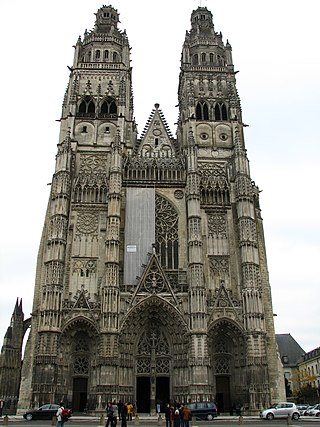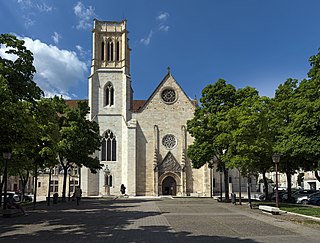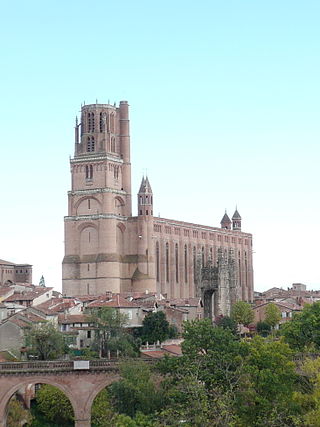
Clovis was the first king of the Franks to unite all of the Frankish tribes under one ruler, changing the form of leadership from a group of petty kings to rule by a single king and ensuring that the kingship was passed down to his heirs. He is considered to have been the founder of the Merovingian dynasty, which ruled the Frankish kingdom for the next two centuries. Clovis is important in the historiography of France as "the first king of what would become France".

Gregory of Tours was a Gallo-Roman historian and Bishop of Tours during the Merovingian period and is known as the "father of French history." He was a prelate in the Merovingian kingdom, encompassing Gaul's historic region.

The Archdiocese of Tours is a Latin Church archdiocese of the Catholic Church in France. The archdiocese has roots that go back to the 3rd century, while the formal erection of the diocese dates from the 5th century.

Albi is a commune in southern France. It is the prefecture of the Tarn department, on the river Tarn, 85 km northeast of Toulouse. Its inhabitants are called Albigensians. It is the seat of the Archbishop of Albi.

Denis of Paris was a 3rd-century Christian martyr and saint. According to his hagiographies, he was bishop of Paris in the third century and, together with his companions Rusticus and Eleutherius, was martyred for his faith by decapitation. Some accounts placed this during Domitian's persecution and incorrectly identified St Denis of Paris with the Areopagite who was converted by Paul the Apostle and who served as the first bishop of Athens. Assuming Denis's historicity, it is now considered more likely that he suffered under the persecution of the emperor Decius shortly after AD 250.

Fermin was a legendary holy man and martyr, traditionally venerated as the co-patron saint of Navarre, Spain. His death may be associated with either the Decian persecution (250) or Diocletianic Persecution (303).

Saint Hermenegild or Ermengild, was the son of King Liuvigild of the Visigothic Kingdom in the Iberian Peninsula and southern France. He fell out with his father in 579, then revolted the following year. During his rebellion, he converted from Arianism to Chalcedonian Christianity. Hermenegild was defeated in 584 and exiled. His death was later celebrated as a martyrdom due to the influence of Pope Gregory I's Dialogues, in which he portrayed Hermenegild as a "Catholic martyr rebelling against the tyranny of an Arian father."

Maurus (512–584) was the first disciple of Benedict of Nursia. He is mentioned in Gregory the Great's biography of the latter as the first oblate, offered to the monastery by his noble Roman parents as a young boy to be brought up in the monastic life.
Marius Aventicensis or, popularly, Marius of Avenches was the Bishop of Aventicum from 574, remembered for his terse chronicle. After his death in Lausanne, he was venerated in that city as a saint, and his feast day was celebrated on 9 or 12 February.

The Diocese of Agen is a Latin Church ecclesiastical territory or diocese of the Catholic Church in France.

The Diocese of Angoulême is a Latin diocese of the Catholic Church in France. Originally erected in the 3rd century, the episcopal see is the Angoulême Cathedral. Comprising the département of the Charente, the diocese had traditionally been suffragan to the Archbishopric of Bordeaux, under the old régime as well as under the Concordat, but since 2002 is suffragan to the Archdiocese of Poitiers.

The Diocese of Valence (–Die–Saint-Paul-Trois-Châteaux) (Latin: Dioecesis Valentinensis ; French: Diocèse de Valence is a Latin Church diocese of the Catholic Church in southern France. The contemporary diocese is co-extensive with the department of Drôme.

Saint Gaugericus, in French Saint Géry was a bishop of Cambrai, France.

The bishopric of Lavaur was founded by Pope John XXII in his plan to reorganize the sprawling diocese of Toulouse. The town is situated some fifteen miles to the east of Toulouse. Lavaur had the reputation of being one of the strongest centers of Catharism, being referred to as sedes Satanae, atque erroris haeretici primatica ('seat of Satan and prime source of heretical error' The diocese consisted of some 80–90 parishes. It hosted one abbey, that of Sorèz, a convent of the Clarisses, a convent of the Daughters of the Cross, a convent of Dominicans, one of Franciscans, one of Capuchins, two of reformed Dominicans, and two houses of the Doctrinaires. The diocese produced some 35,000 livres for the bishop.

The former French diocese of Saintes existed from the 6th century to the French Revolution. Its bishops had their see in the cathedral of Saintes in western France, in the modern department of Charente-Maritime. After the Concordat of 1801, the diocese was abolished and its territory passed mainly to the Diocese of La Rochelle, the name of which was changed in 1862 to the present Diocese of La Rochelle and Saintes.

The Diocese of Mende is a Latin diocese of the Catholic Church in France. The diocese covers the department of Lozère.

The Archdiocese of Albi(Latin: Archidioecesis Albiensis–Castrensis–Vauriensis); is a Latin archdiocese of the Catholic Church in France. It is suffragan to the Archdiocese of Toulouse, and it comprises the department of Tarn.

The Archdiocese of Clermont is a Latin archdiocese of the Roman Catholic Church in France. The diocese comprises the department of Puy-de-Dôme, in the Region of Auvergne. The Archbishop's seat is Clermont-Ferrand Cathedral. Throughout its history Clermont was the senior suffragan of the Archdiocese of Bourges. It became a metropolitan see itself, however, in 2002. The current archbishop is François Kalist.
Desideratus or Desiderius of Verdun was Bishop of Verdun in France from 529 to 554. He is venerated as a Catholic saint, with his feast day on 23 August.

Saint Salvius of Amiens was a 7th-century bishop of Amiens. His feast day is 11 January.


















